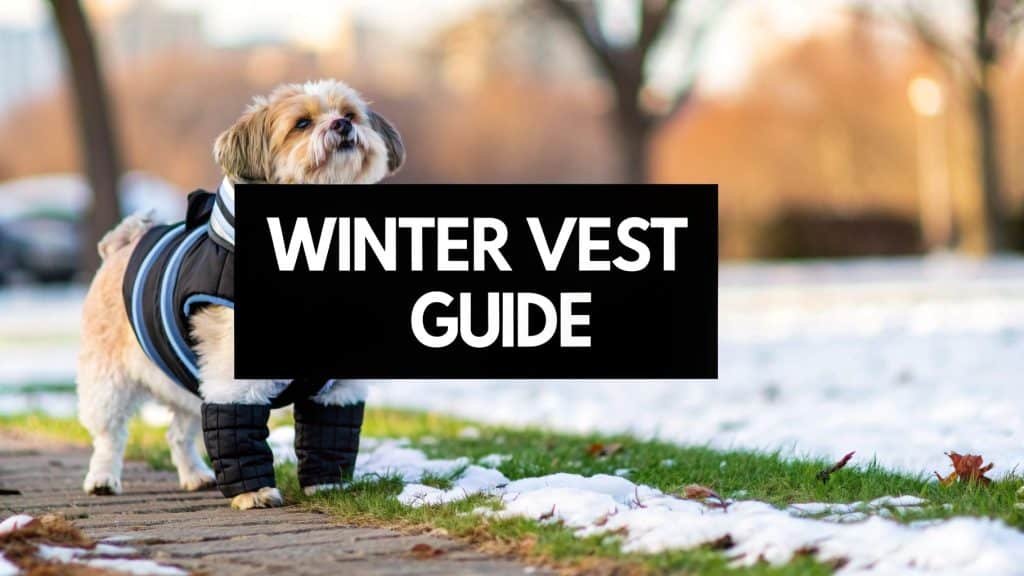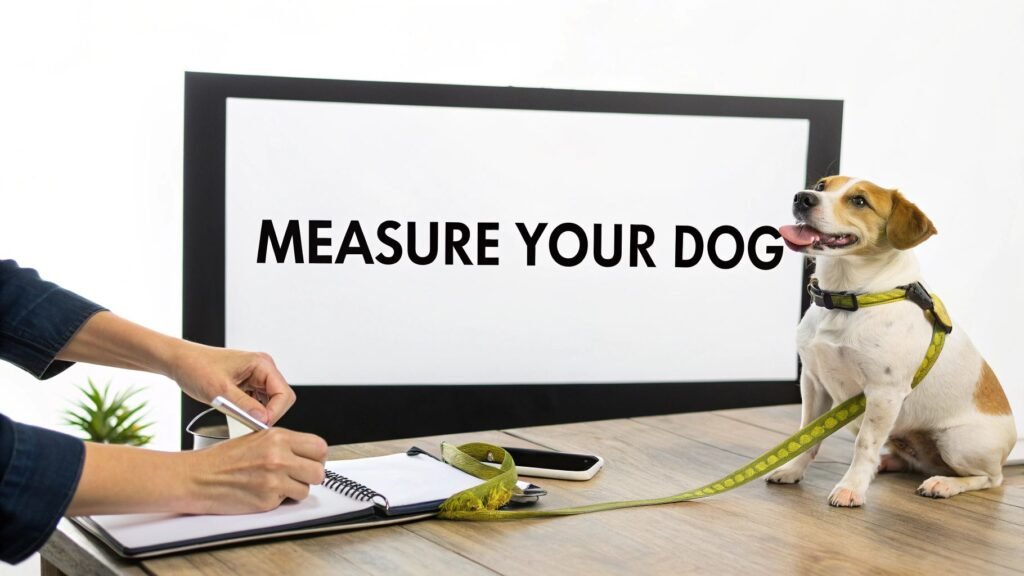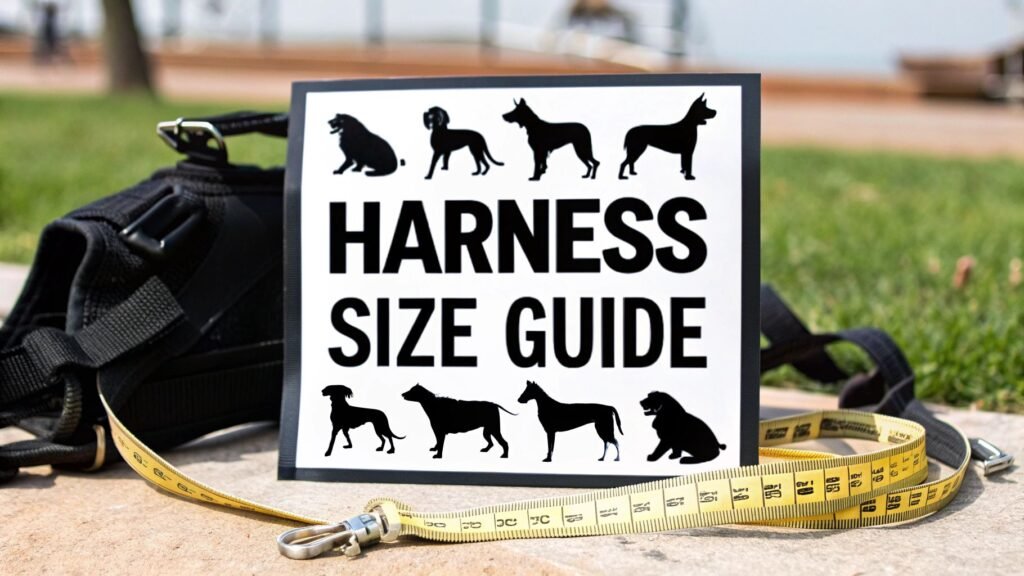Measurements for Dog Harness: Find the Perfect Fit
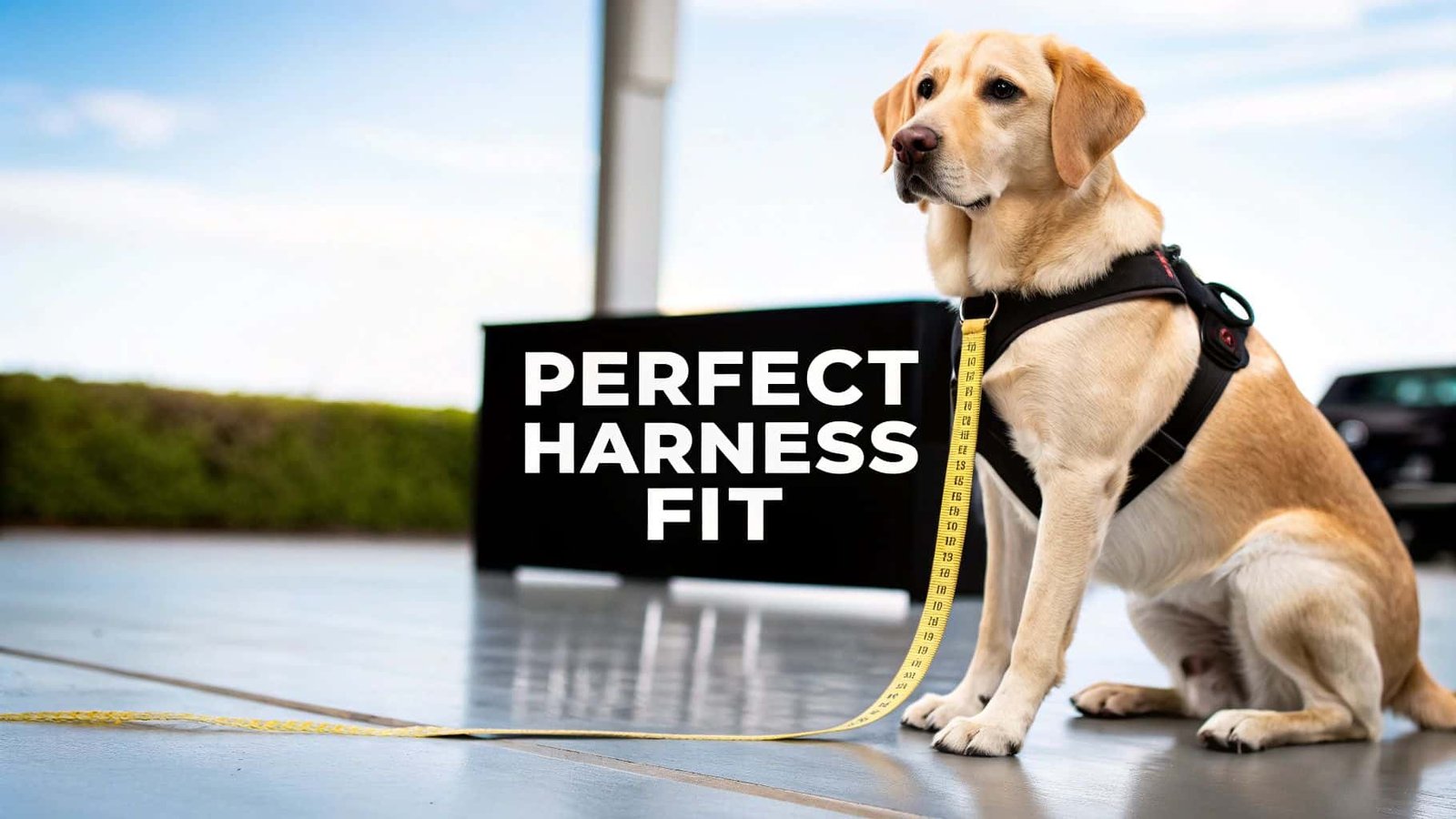
Finding the right harness for your dog is about more than just picking a cool color. It’s a matter of safety and comfort, and getting the measurements for dog harness right is the first and most important step. A bad fit can lead to chafing, restricted movement, or worse, an escape artist on the loose. Taking just a few minutes to measure can save you a world of trouble down the road.
Why You Can’t Afford to Guess on Harness Size
A good harness is a fantastic piece of gear. Unlike a collar that can put a dangerous amount of pressure on your dog’s throat, a harness spreads that force across the stronger chest and shoulder areas. This is a game-changer for dogs that pull and a must-have for smaller breeds susceptible to tracheal collapse.
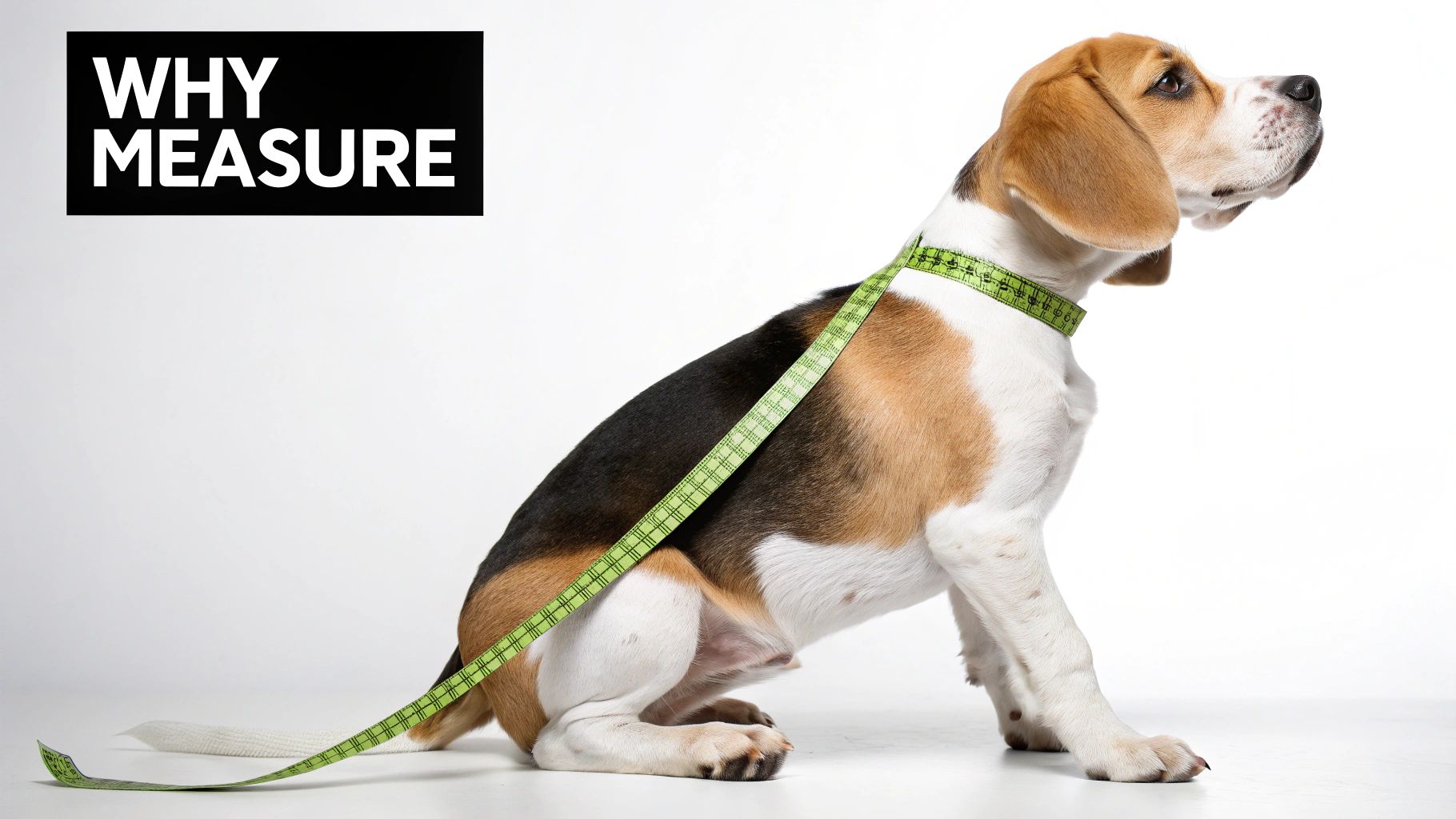
It’s no surprise that more and more owners are making the switch. The global market for dog harnesses hit about USD 2.0 billion and is expected to climb to USD 3.5 billion by 2032. People are prioritizing safer, more ergonomic designs that keep their dogs comfortable. You can dive deeper into how the industry is evolving for pet safety to see just how big this trend has become.
The Real Dangers of a Poorly Fitted Harness
Getting the fit wrong isn’t just a minor inconvenience; it can cause real problems for your dog.
- Painful Chafing and Sores: If a harness is too snug, it will constantly rub against your dog’s skin. The area behind the front legs is particularly sensitive. This constant friction can lead to raw, painful sores and even skin infections.
- Restricted Movement: I’ve seen harnesses that sit too high on the shoulders, completely changing a dog’s natural gait. This doesn’t just make walks awkward; over time, it can contribute to long-term joint and mobility issues.
- The Houdini Effect: On the flip side, a harness that’s too loose is an open invitation for an escape. All it takes is one squirrel or loud noise for a scared dog to back right out of it, putting them in the path of traffic or other dangers.
Taking accurate measurements for dog harness isn’t just about following instructions—it’s about ensuring every walk is safe, comfortable, and stress-free for both you and your best friend.
At the end of the day, a few moments with a soft measuring tape is a tiny investment that pays off big. It prevents discomfort, saves you from potential vet bills, and gives you the peace of mind that your dog is secure on every adventure.
The Simple Tools You Need to Get Started
You’ll be happy to know you don’t need any special equipment to get your dog’s measurements right. In fact, everything you need is probably already in a drawer somewhere in your house.
The absolute best tool for this job is a soft, flexible measuring tape—the kind you’d find in a sewing kit. Because it’s so pliable, it wraps smoothly around your dog’s body, giving you a snug, accurate reading without any fuss. It’s my go-to every time.
What If You Don’t Have a Flexible Tape?
No worries at all if you can’t find one. This is where you can get a little creative with things you have on hand.
I’ve successfully used all sorts of substitutes. Pretty much any non-stretchy cord will do the trick:
- A piece of string or yarn
- A ribbon or a shoelace
- Even a phone charging cable in a pinch
Just wrap your makeshift measuring tool around your dog, pinch the spot where the end meets the length, and then lay it flat next to a rigid ruler or a metal tape measure to get the exact number.
The most important thing here is getting a true-to-form measurement. A flexible tool, whether it’s a proper sewing tape or just a piece of string, is the secret to nailing the fit.
Lastly, make sure you have some of your dog’s favorite high-value treats on hand to keep the mood light and positive. This is also a great time to consider a quick brush-down, as a matted or puffy coat can throw off your numbers. You can learn more about the best brushes for Labrador Retrievers, and the advice there is helpful for many breeds with dense fur.
How to Measure Your Dog’s Chest Girth
If there’s one measurement you absolutely have to get right for a dog harness, it’s the chest girth. This single number is the make-or-break factor for a good fit. Get it wrong, and you’re looking at a harness that’s either dangerously loose or uncomfortably tight.
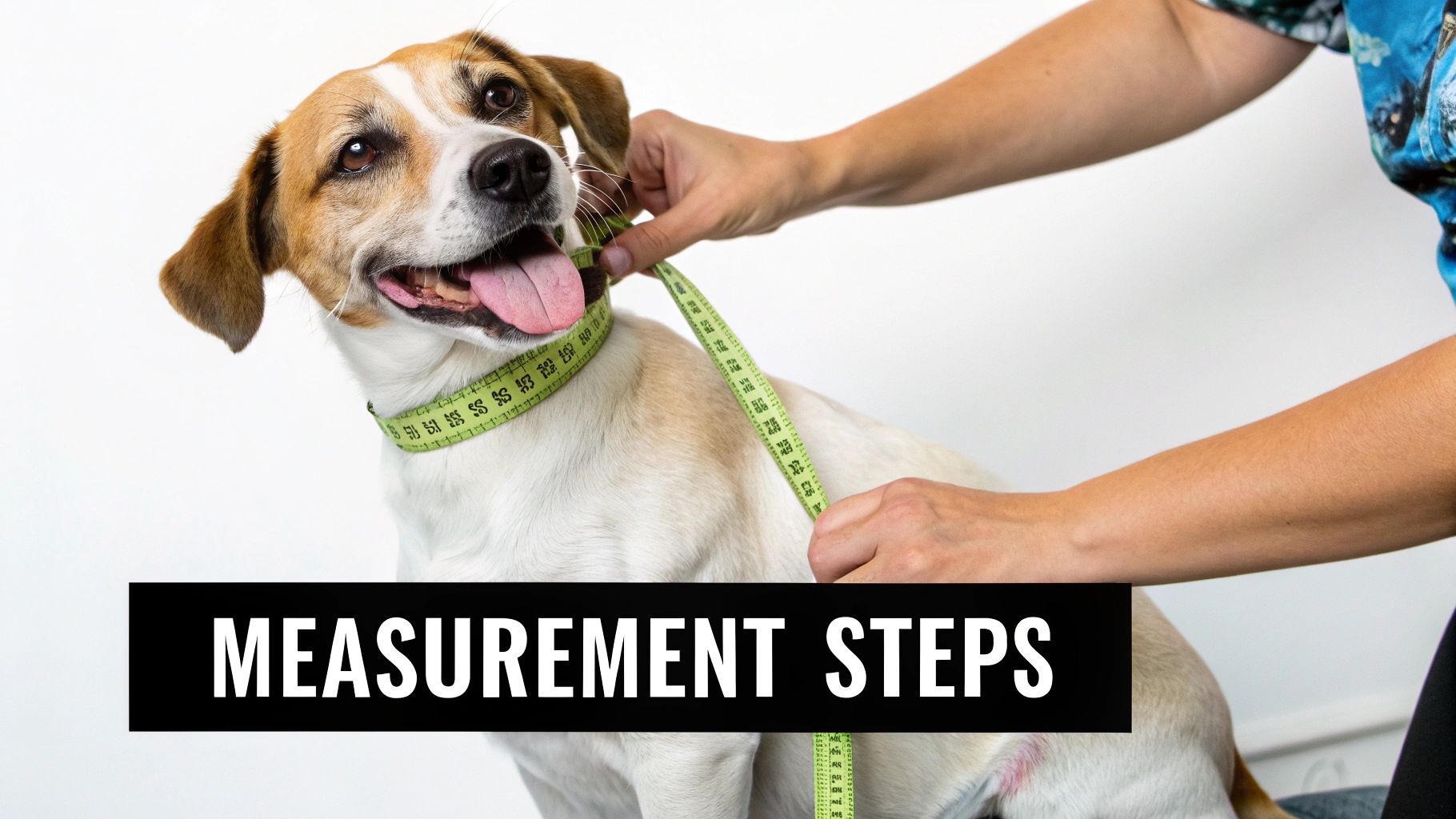
So, where is the magic spot? You’re looking for the widest part of your dog’s ribcage. On most dogs, this is right behind their front legs. Think of it as the deepest part of their chest.
Finding the Sweet Spot for Measurement
First, get your dog standing up. If you’ve got a wiggler on your hands, a little distraction can go a long way—a lick mat with some xylitol-free peanut butter is my go-to trick.
Take your soft measuring tape and wrap it around their chest at that widest point I mentioned. You want the tape to be snug, but definitely not tight. You’re not cinching a belt; you just need to know the actual size. A classic rookie mistake is measuring too high up in their “armpits,” which is a surefire way to get a harness that chafes.
The Two-Finger Rule
Here’s a tried-and-true method: once the tape is around their chest, you should be able to comfortably slip two fingers (stacked flat) between the tape and your dog’s body. This simple trick ensures the harness will have enough room for them to move and breathe easily without being restrictive.
Practical Tips for Different Dogs
Every dog is different, and getting that measurement can sometimes feel like a two-person job.
- For the Wiggly Pup: Speed is your friend. Have a helper ready with a high-value treat to keep their attention for the few seconds it takes to get a reading.
- For the Fluffy Dog: If your dog has a thick or long coat, you need to measure the dog, not the fur. Gently compress the fluff with the tape so you’re getting a true measurement of their body.
- For the Calm Senior: Take advantage of their patience! Measure twice to be certain you’ve got it right. An accurate fit is key to making their walks as comfortable as possible.
With this key measurement in hand, you’re ready to find the right gear. For instance, our best-selling tactical dog harness depends on an accurate chest girth to deliver its secure, no-slip fit. A precise measurement is what prevents rubbing and ensures the harness works like it’s supposed to, keeping your dog safe and comfortable on all your adventures.
Measuring Neck and Back for Specialized Harnesses
While chest girth is the king of measurements for most harnesses, some styles demand a closer look at your dog’s neck and back length. This isn’t just extra work—it’s absolutely crucial for specialized gear like no-pull, tactical, or mobility-assistance harnesses. For these, a perfect fit is what makes them work safely and effectively.
Getting these extra numbers is simple, but the technique is a little different than you might expect. One of the most common mistakes I see is an incorrect neck measurement, so let’s get that one right first.
The Correct Way to Measure Your Dog’s Neck
Forget everything you know about measuring for a collar. When you’re fitting a harness, you don’t want the tape measure high up by the ears.
Instead, you need to measure the lower part of the neck, right at the base where it broadens to meet the shoulders. This is the natural spot where the front straps of the harness will actually sit. Wrap your flexible tape measure around this area—it should be snug, but not constricting. A good rule of thumb is to make sure you can comfortably slip two fingers underneath the tape. This simple trick ensures the harness won’t ride up and press against your dog’s throat.
When Back Length Becomes Important
Back length isn’t a measurement you’ll need for a standard, everyday walking harness. However, it becomes essential for any style that provides more coverage along your dog’s back. Think of things like tactical vests, hiking packs, or harnesses used in canine sports.
To measure the back, run your tape from the base of the neck (that spot right between the shoulder blades) all the way to the base of the tail. A precise back measurement guarantees the harness won’t be too long, which could interfere with your dog’s hip movement and cause serious discomfort.
The chart below gives you a good idea of how average neck and chest measurements compare across different sizes, showing why measuring both is so important.
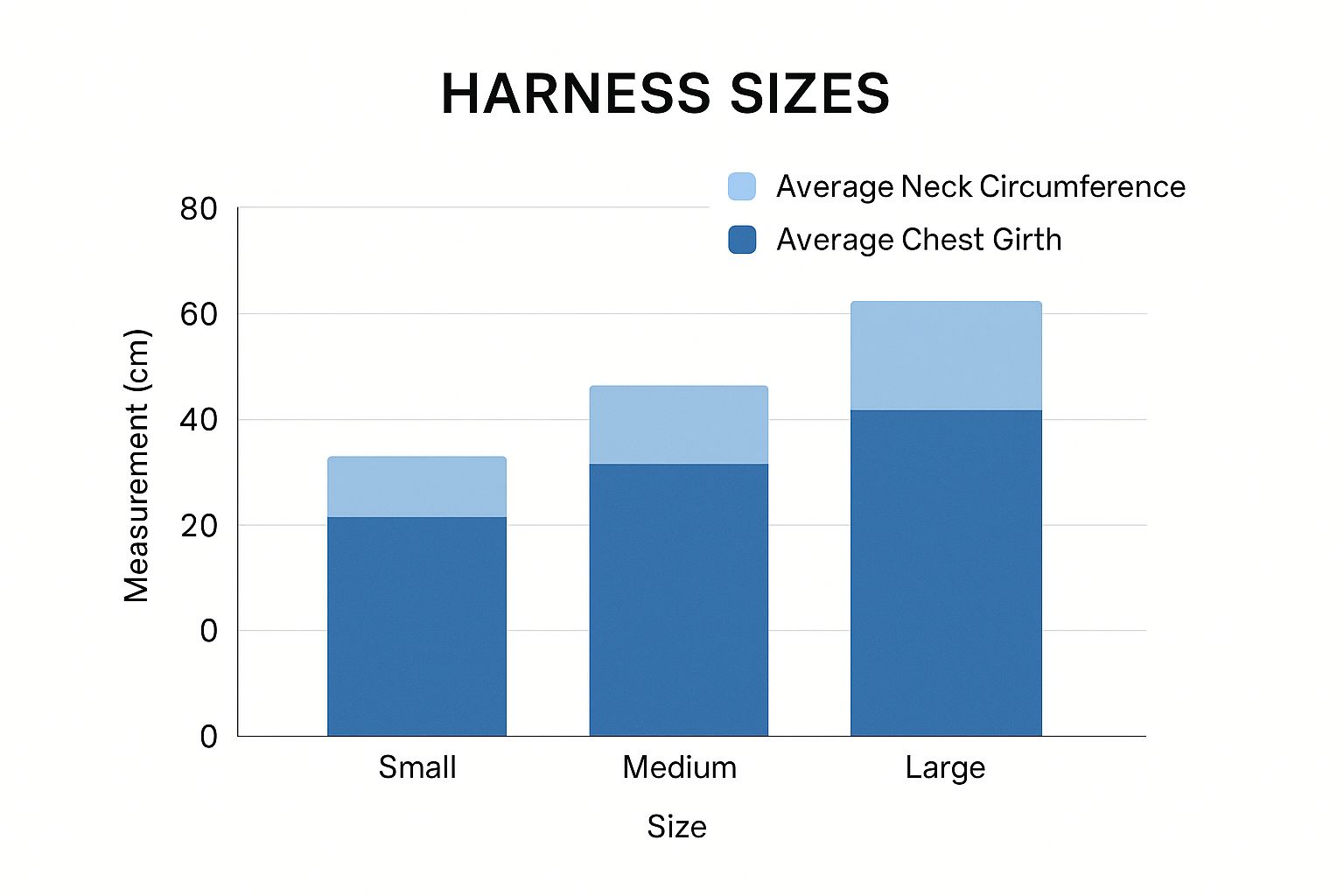
As you can see, the ratio isn’t always what you’d expect, which is why you can’t just guess one measurement based on another. This is especially true given the huge variety of harness options out there. High dog ownership has fueled a massive industry, and with the market valued in the billions, brands offer more sizes than ever. You can learn more about the growth of the pet accessories market here. Taking the time to get accurate neck, chest, and back measurements is your best bet for navigating all those options.
Not every harness relies on the same measurements. Use this guide to see which ones are most important for the style you’re considering.
Key Measurements for Common Harness Types
| Harness Type | Primary Measurement | Secondary Measurement | Good to Know |
|---|---|---|---|
| Standard/Vest Harness | Chest Girth | Neck Girth | The most common type; chest is the make-or-break measurement. |
| No-Pull (Front-Clip) | Chest Girth | Neck Girth | A good neck fit prevents the harness from shifting to the side. |
| Step-In Harness | Chest Girth | N/A | Primarily relies on chest girth, as it sits lower on the body. |
| Mobility/Lifting Harness | Back Length | Chest Girth | Back length is critical to ensure support is distributed correctly. |
| Tactical/Hiking Harness | Back Length | Chest & Neck Girth | All three measurements are vital for a secure, non-restrictive fit. |
Ultimately, taking these extra measurements for more complex harnesses ensures they provide the support and security they were designed for, all without getting in the way of your dog’s comfort or freedom of movement.
Key Takeaway: For specialized harnesses, don’t skip the neck and back measurements. Measure the low neck, not the high neck, and run the tape from the shoulder blades to the tail’s base for an accurate back length.
Making Sense of Sizing Charts and Sidestepping Common Mistakes
You’ve got your dog’s measurements—now for the moment of truth. It’s time to match those numbers to a sizing chart. This seems like the easy part, but I’ve seen it time and time again: this is where perfectly good measurements lead to a frustrating return. Every single brand does their sizing a little differently, so you have to treat each chart like it’s the first one you’ve ever seen.
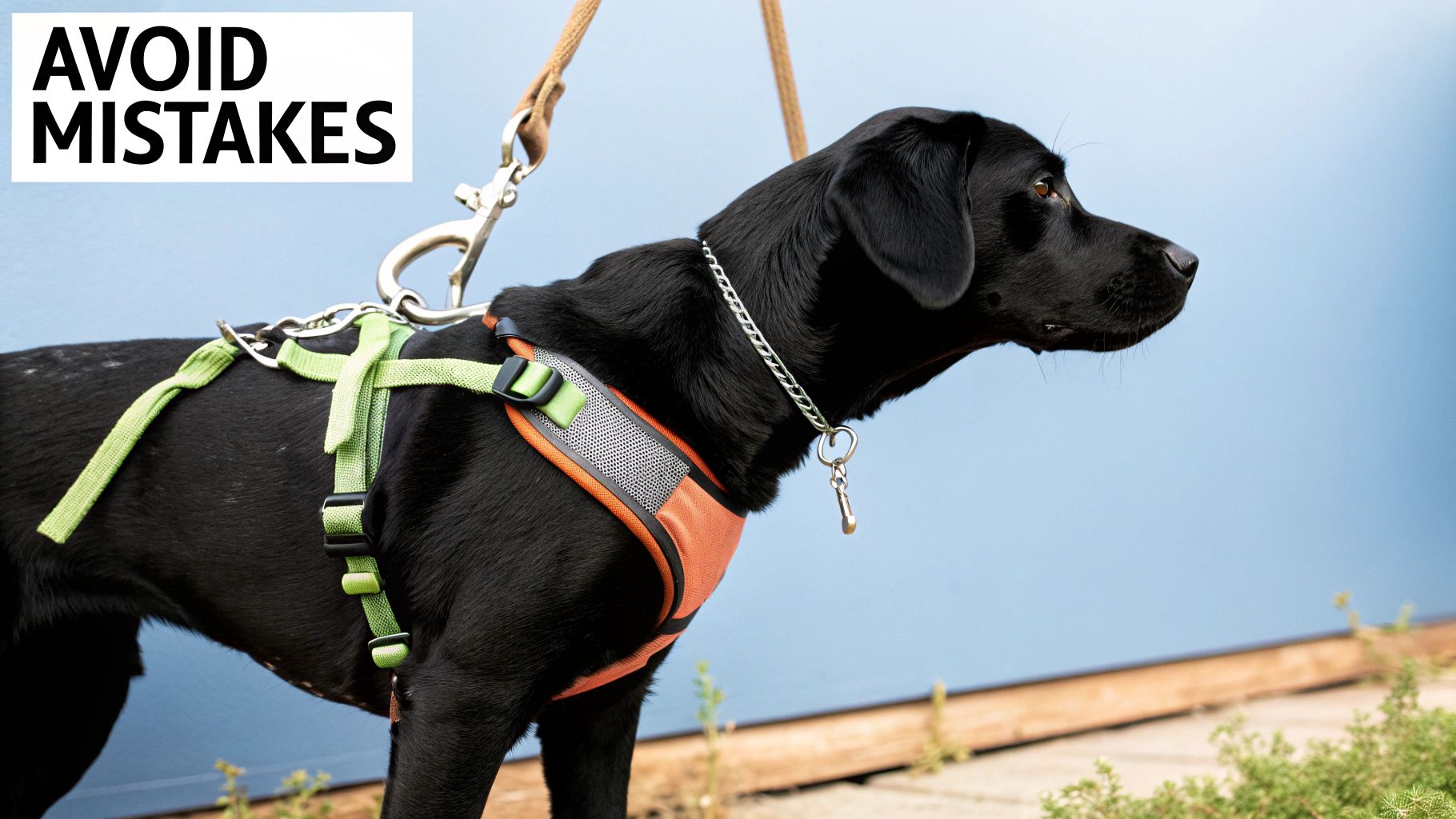
If you take away one thing, let it be this: never, ever assume your dog’s size. Just because your German Shepherd wears a “Large” from one brand doesn’t mean they won’t need an “XL” from another. Your dog isn’t a “medium” or a “large”—they have a 28-inch chest and a 19-inch neck. Always go by the numbers.
The Classic “In-Between” Problem
It’s a tale as old as online shopping. Your dog’s chest is exactly 24 inches. You look at the chart, and the Medium is for 20-24″ while the Large is for 24-28″. They’re on the cusp. What’s the right call?
The Golden Rule for Dog Gear
When in doubt, size up. If your dog falls right between two sizes, always pick the larger one. You can almost always tighten a harness that’s a little big, but you can’t stretch one that’s too small.
Thankfully, most quality harnesses these days have multiple adjustment points. This isn’t just a nice feature; it’s essential for a good fit. In fact, getting the fit right can lead to customer satisfaction being up to 25% higher—something we take seriously. These adjustable straps are your best friend, making it easy to snug down a slightly roomier harness for a secure, wiggle-proof fit.
Little Mistakes That Throw Off Your Measurements
Even with the best intentions, a few simple slip-ups can make your carefully taken numbers totally inaccurate. Keep an eye out for these common culprits:
- Measuring the Fluff, Not the Dog: If you have a fluffy friend like a Samoyed or a Golden Retriever, you need to gently part their fur and make sure the measuring tape is snug against their actual body.
- Pulling the Tape Too Tight: The tape should be firm, but it shouldn’t be digging into your dog’s skin or constricting their breathing. Think “snug,” not “strangling.”
- Measuring a Napping Pup: Make sure your dog is standing up straight on all fours. Measuring them while they’re lying down will completely skew the chest and length dimensions.
Dodge these simple mistakes, and you can be confident in your numbers. From there, it’s just a matter of matching them to the chart and finding that perfect fit from our collection of collars, leashes, and harnesses.
Common Questions About Getting the Right Harness Fit
Even after you’ve carefully measured your dog, a few questions can still pop up. It happens to everyone. Let’s walk through some of the most common issues people run into when sizing up their dog for a new harness.
What If My Dog Is Between Two Sizes?
This is probably the most frequent dilemma we see, and the answer is simple: always choose the larger size. It’s much better to have a little extra room you can cinch down with the adjustable straps.
Think of it this way—a harness that’s slightly too big can almost always be adjusted for a snug, secure fit. But a harness that’s too small is useless. It’ll pinch, chafe, and restrict your dog’s natural movement, which is both uncomfortable and unsafe. You can’t add fabric, so sizing up is the only logical choice.
How Do I Measure a Dog with a Thick, Fluffy Coat?
For breeds like Pomeranians, Huskies, or even a fluffy Golden Retriever, that cloud of fur can be deceiving. The trick is to measure the dog, not the fluff.
When you wrap the measuring tape around their neck or chest, gently compress their fur until the tape is snug against their actual body. You want a firm measurement without actually squeezing your dog. This ensures the harness sits correctly on their frame and won’t get loose and sloppy once the straps press down all that hair.
Your job is to give the brand your dog’s true measurements. Harness designers have already accounted for comfort and movement in their sizing charts, so trust the numbers you get.
Should I Add Extra Inches to My Measurements for “Wiggle Room”?
Absolutely not. It’s a tempting thought, but adding a few inches “just in case” will almost guarantee you buy the wrong size.
Provide the most accurate, snug measurements you can take. The “wiggle room” comes from the harness design itself and your final adjustments. Once you have the harness, use the classic two-finger rule to check the fit. If you can comfortably slip two fingers between your dog and any strap, you’ve nailed it.
Finding the perfect harness starts with getting the right numbers. Explore our full collection of high-quality, adjustable harnesses at Ur Pet Store to find the ideal match for your best friend.


